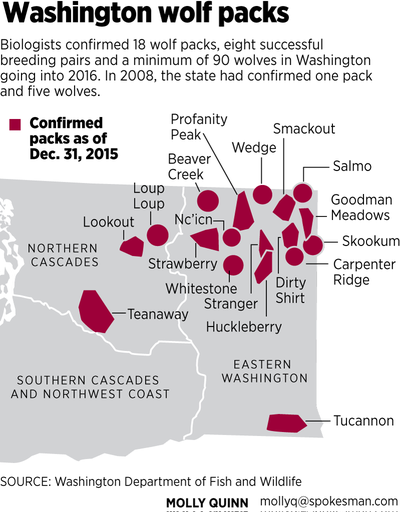Tucannon wolf pack suspected of killing calf in Asotin County

Protected wolves have made their first confirmed strike against livestock in southeastern Washington.
State Department of Fish and Wildlife officials confirmed Tuesday that a calf was killed by a wolf or wolves about 10 miles southwest of Asotin.
Donny Martorello, the state’s wolf policy leader at Olympia, said the 4-day-old calf was killed Monday on a 90-acre, fenced pasture belonging to a livestock producer. The killing marks the first time any livestock in the county, or in the Washington portion of the Blue Mountains, has been confirmed to have been lost to wolves since the predators began to recolonize the state in 2008.
In other wolf news, a suspected wolf poaching involving the Diamond Pack in northeastern Washington is being investigated, Martorello said Thursday.
Meanwhile, he said, wildlife conflict specialists are working with the Asotin County rancher, whose name has not been released, and other nearby livestock producers on measures to prevent future depredations.
He said that could include things like placing flagging around calving areas and using lights to scare wolves. The rancher, like many who work in areas that are home to predators, already uses a range rider to help protect his animals.
Wolves inhabiting the eastern third of the state are not protected by the federal government, but they are protected across Washington under the state’s Endangered Species Act. Even so, the Washington Wolf Conservation and Management Plan allows wildlife officials to use lethal measures as a last resort to stop livestock depredations.
“If we see repeated depredations that we expect to continue and we have tried those preventive tools and they are not curbing those depredations, we consider lethal control,” Martorello said.
The area where the calf was killed is on the eastern edge of the Tucannon Pack’s range. Although Martorello said it’s not known for sure that the pack was responsible, it is likely. Other wolves, particularly younger animals looking for new territory, have been known to pass through the area. But Martorello said those animals are generally wary of trespassing on the marked territory of the established pack and instead skirt its perimeter.
“We suspect this is probably the Tucannon Pack. It’s within its territory, but it’s not a bright line,” he said.
The Tucannon Pack was officially recognized in 2013 and began spending much of its time in Asotin County last year. One of its founding members, known as OR15, was wearing a collar that allowed biologists to keep track of the animals and establish their geographic territory. However, the collar has since failed and wildlife officials haven’t yet been able to place another collar on one of the pack’s members.
The pack produced five pups last year and at least three of them survived, according to district wildlife biologist Paul Wik.